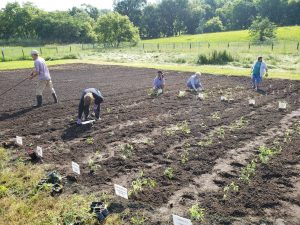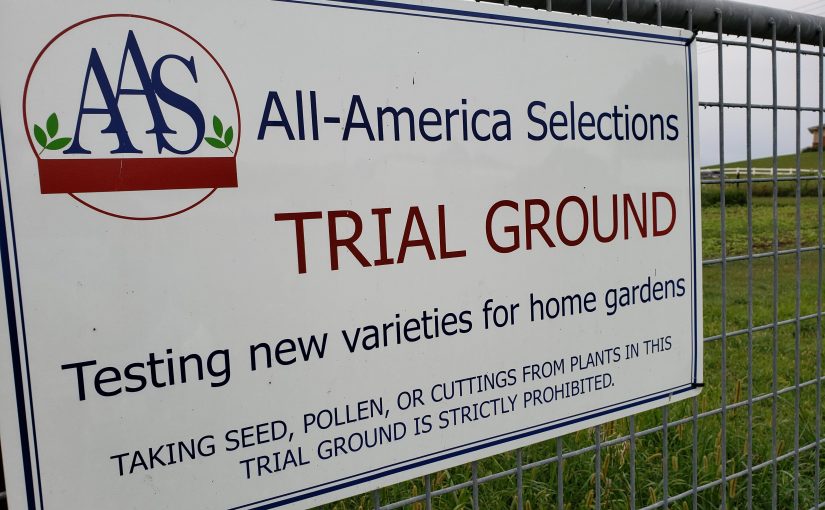How do you know that plants will do well in your garden? Do you research the types of plants for your region, study different cultivars, and select only things that have been proven to do well for your conditions? Or do you buy what catches your eye at the garden center, plant it, and then see what happens? I used to joke that my home garden was a horticulture experiment station, since I’d try all kinds of random plants or techniques and see what works for me. Now, ![]() I get to do that as a fun part of my job through the All-America Selections (AAS) program. You’ve likely seen the AAS symbol on plants or seed packets at the garden center or in catalogs. Heck, you may even have them in your garden (and not know it). I compare it to the “Good Housekeeping Seal of Approval” that you used to see on appliances, cleaners, etc. The AAS program is a non-profit started in the 1930’s with the goal of evaluating new plants so that home gardeners can purchase high quality seeds and plants and to assist the horticulture industry in marketing innovations from their breeding programs. You can read more about AAS and its history here.
I get to do that as a fun part of my job through the All-America Selections (AAS) program. You’ve likely seen the AAS symbol on plants or seed packets at the garden center or in catalogs. Heck, you may even have them in your garden (and not know it). I compare it to the “Good Housekeeping Seal of Approval” that you used to see on appliances, cleaners, etc. The AAS program is a non-profit started in the 1930’s with the goal of evaluating new plants so that home gardeners can purchase high quality seeds and plants and to assist the horticulture industry in marketing innovations from their breeding programs. You can read more about AAS and its history here.
A few weeks ago I traveled to Chicago for the All-America Selections (AAS) Annual Summit to receive their Judge Ambassador Award. I had signed up a few years ago to be a trial site for edible crops for AAS. The following year I talked my colleague Scott into signing up as a judge for their ornamental trials. The fun thing about the program is that we get to grow all kinds of vegetables, fruits, and flowers that aren’t even on the market yet. We get to see how well they grow compared to similar plants and rate them on a number of factors including growth habit, disease resistance, and performance plus flavor (for edible crops) or flower color/form (for ornamentals). It can be hard work, but it is rewarding to help identify true plant innovations and to see your favorites be announced as winners.
How the testing works
While the AAS Trials may not have the rigor of academic crop research, I do appreciate the procedures in place that provide objective and high standard results.
Breeders, developers, and horticultural companies submit their new plants that are planned for future introduction to the board of AAS for consideration in the trialing program. During the application process, novel traits of the plants are identified to ensure that the plant offers something new and exciting – these are the traits that judges will observe and score. The board reviews the application to determine if it fits within the program rules.

One great thing about the program is that trial judges are professional horticulturalists from universities, seed companies, botanical gardens, etc. – they’re people who know how to grow things and know what quality plants look and act like. There are trial sites all around the country, providing for replication and generalizeable results for most regions of the country. The conditions plants are grown in also vary by location. My trial is at a farm where management is minimal. When we were at the summit we visited the trial gardens at Ball Horticulture which looked much more maintained and pampered compared to mine. This gives data on a variety of maintenance levels as you’ll find in home gardens – some gardeners are very conscientious about maintaining their plants and others have a more laissez faire approach. In order to win as a full national AAS winner, the plants have to perform well across the country in all these different situations. Sometimes those that perform well in a few regions but not the others will be designated as regional winners.
Second, the tests are blind. This means that we do not know what the exact plant is, who the breeder or seed company is, or any other info other than what type of plant it is. To the judge, each entry is just a number. It could be from a seed company you love (or hate), your best friend, the breeder who was your advisor from grad school, etc. This makes the results fair and reduces the chance for bias toward or against a plant based on its origins. The ratings are just based on the plant.
Another part of the trial is comparison. It is one thing to grow a tomato plant and say “yep, that’s a good tomato.” Its another to grow a tomato and compare it to similar cultivars to say “yep, that’s a good tomato….but it is better than what’s already available on the market.” The goal of the program is to show how new plants have merit over older plants. We only need so many new tomatoes (and let’s face it, there are lots of new tomatoes – we test WAY too many in the AAS process for my liking). The board of AAS judges reads the entry info from the new cultivar being tested and selects plants (usually two) to compare it against. If the trial is a yellow cherry tomato, it will be grown and tested alongside other yellow cherry tomatoes. The scoring is based on whether its performance or taste is as good as or better than the comparisons. If most judges don’t rank it as “better” then it has no chance of winning.
Confidentiality and Proprietary Plants
The fact that the testing is blind, paired with the fact that results of “failed” tests are not released, lends itself to confidentiality. Another important factor about the testing is the proprietary nature of the tests and test sites. These are new plants that haven’t been introduced to the market (except for the case of perennial trials) and are usually for proprietary or patented plants. Test sites should have some sort of control over who enters them and signs prohibiting the collection of seeds, pollen, or cuttings are placed at the site. Believe it or not, the world of plant introductions can be dog-eat-dog and cutthroat.
So what if it doesn’t win?
One of the cool things about the test is seeing the announcements of the winners early the following year. You see the list of plants and think back to what you grew the previous season. If often find myself thinking “oh yeah, I remember that plant, it did really well” and sometimes even “how did that win, it did horrible for me.” This is a good reminder that we can’t base generalized garden recommendations on anecdotal evidence. What did well for me may not work for someone else and vice versa. All the results from the test sites go together to provide a general view of the plant performance. It will do well for some and not others.
So if most of the judges rank the crop as not performing, looking, or tasting as good as the comparisons the plant doesn’t win. And that’s it. Due to the confidential nature of the testing you won’t know that it failed the test. Even I won’t know that it failed the test. It will likely go on to market without the AAS seal where it will face an even tougher test – the test of consumer demand. Of course, many people may grow it and be successful, and some may grow it without success.
What are the AAS Winners and how do I find them?
There’s a list of plants announced each year through the AAS website and social media channels. You can find a list, in reverse order of winning (meaning most recent first) on the AAS Website. The site also has a searchable database if you’re looking for a specific plant. Since these plants are owned by lots of different seed companies and breeders, there’s also a retailer listing on the site. The AAS program also supports a number of Display Gardens across the country, including botanical gardens, university gardens, and others where the public can see the most recent winners growing. Here in Omaha we maintain a display garden for the ornamental plants at our county fairgrounds. We also have our on-campus garden which is used for our TV show Backyard Farmer (the longest running educational TV program in the country, BTW) which serves as a display garden for both ornamental and edible crops.
I recently shared the AAS Testing Program with the local news here in Omaha. Check it out:
Some of my favorite recent AAS Winners
 Asian Delight Pak Choi – this was planted in May and didn’t bolt. We were still harvesting it in October.
Asian Delight Pak Choi – this was planted in May and didn’t bolt. We were still harvesting it in October.

Pepper Just Sweet – these plants were big and healthy even when everything else was struggling. The peppers were delicious.

Potato Clancy – potatoes….from seed! Just fun!
 Pepper Habanero Roulette – All of the fruity sweet, none of the heat. A fun heatless habanero.
Pepper Habanero Roulette – All of the fruity sweet, none of the heat. A fun heatless habanero.
 Dianthus Intraspecific Supra Pink– A reblooming, prolific Dianthus with interesting ruffled flowers.
Dianthus Intraspecific Supra Pink– A reblooming, prolific Dianthus with interesting ruffled flowers.
 Eggplant Patio Baby – container sized eggplant with mini fruits perfect for cooking or roasting whole.
Eggplant Patio Baby – container sized eggplant with mini fruits perfect for cooking or roasting whole.
 Ornamental Pepper Black Pearl – Cute purple flowers lead to these shiny pepper pearls. Love the black leaves, too.
Ornamental Pepper Black Pearl – Cute purple flowers lead to these shiny pepper pearls. Love the black leaves, too.
